SEWAGE TREATMENT
Septic tank - distance from your house to respect
OVERVIEW
When it comes to individual sewage treatment systems, understanding the regulations for septic tank distance from the house can be challenging, particularly in the UK, where legislation differs across four distinct regions: England, Scotland, Wales, and Northern Ireland.
What Are the Regulations for Septic Tank Distance from House?
If you’re considering installing a septic tank, it’s important to know the specific requirements for septic tank distance from your house in the UK. Each local authority may have slightly different rules, but general guidelines are provided to ensure safety, efficiency, and environmental compliance.
Introduction :
One of the key requirements for any septic tank installation is maintaining a safe distance between the septic tank and your house. These regulations are designed to prevent contamination and protect both groundwater and household environments.
Depending on the type of sewage treatment system and the kind of property you are equipping, the required distance can vary. To ensure compliance and maintain effluent quality, regulatory bodies in the UK have established guidelines for installing septic tanks for single dwellings as well as small communities.
If you plan to install a Tricel Novo or a Tricel Vento system, these regulations apply to you. It is your responsibility as a homeowner to adhere strictly to these requirements to avoid possible sanctions from the Environment Agency. Proper installation and compliance are essential not only for legal reasons but also for the safety and sustainability of your sewage treatment system.
Table of Contents
If you have any questions, feel free to call us
Local Requirements regarding septic tank - distance from your house
If you’re planning to invest in a new sewage treatment solution, whether it’s a domestic sewage treatment plant, septic tank, or even packaged filter system, it’s important to understand the installation requirements. Specifically, the septic tank distance from your house must meet certain guidelines in the UK. Environmental agencies have provided a distance calculator to help ensure compliance. Here’s a breakdown of what the legislation says county by county regarding the required distances for septic tank installations:
Septic Tank – distance from house in England & Wales
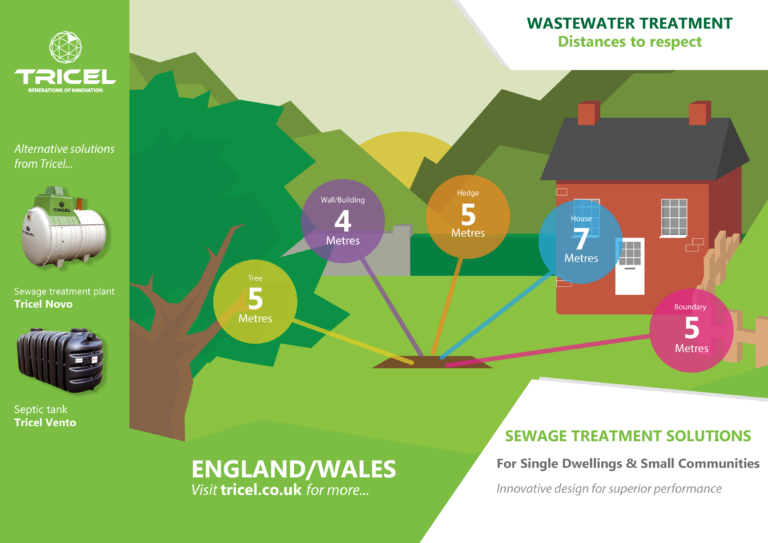
Your sewage treatment plant has to be 5 metres away from trees, fences and hedges, 10 metres away from a watercourse or stream, and 50 metres away from any lake or foreshore. Last but not least, it has to be 7 metres away from your housing and 4 metres apart from a wall or a building.
Septic Tank – distance from house in Scotland
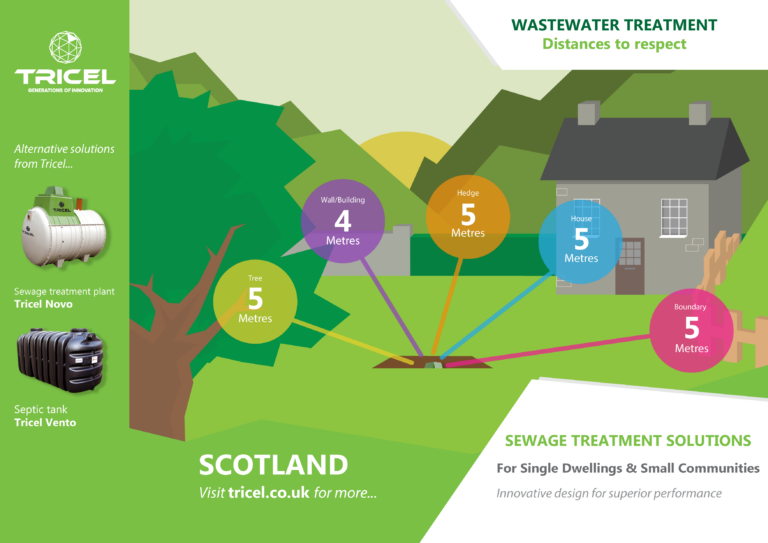
In Scotland, things are slightly different. Trees, hedges and site boundaries such as fences must be 5 metres apart from your sewage system and 4 meters from any wall or building that isn’t your house. As for your house, it must also maintain a distance of at least 5 meters.
Do not hesitate to consult your local agency’s website.
Septic Tank – distance from house in NORTHERN IRELAND
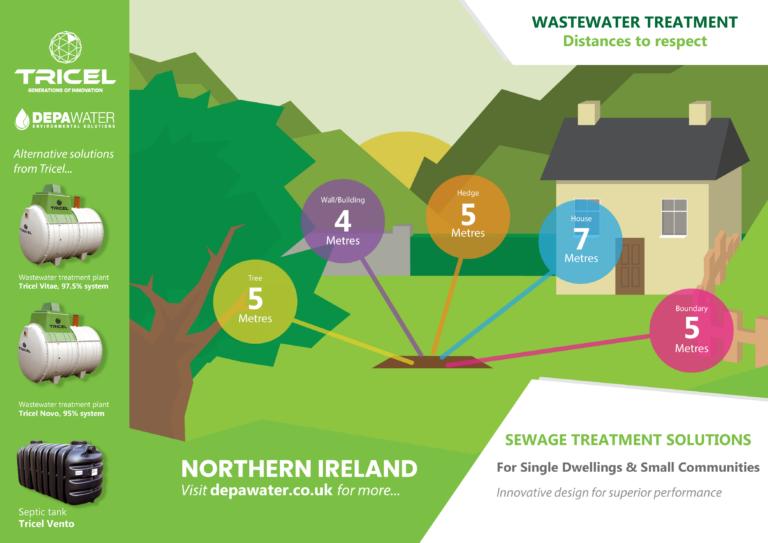
Your septic tank or wastewater treatment plant has to be implanted:
- 5 metres away from trees, hedges and fences.
- 4 metres from a wall/building
- 7 metres away from the house
Introduction to our Septic Tank, the Tricel Vento
Our Tricel Vento septic tank provides sewage water treatment in a cost-effective manner. It offers an affordable solution for those looking to invest in a high-quality tank, while also being easy to transport and simple to install. The treatment occurs within its two chambers: initially, the incoming water is separated from its solid waste, and then it flows into the second chamber, where its quality is further improved before being discharged into the percolation area.
Tricel’s sewage treatment plant, the Novo
With our Tricel Novo sewage treatment plant, We offer an efficient and dependable product for homeowners seeking a reliable investment. The Novo, with no moving parts or pumps, ensures consistent operation while minimising repair and maintenance costs. Its compression-molded SMC tank represents one of the most advanced technologies available. Our sewage treatment system complies with EN12566-3 CE Certification, fully adhering to environmental regulations.
Tricel product range
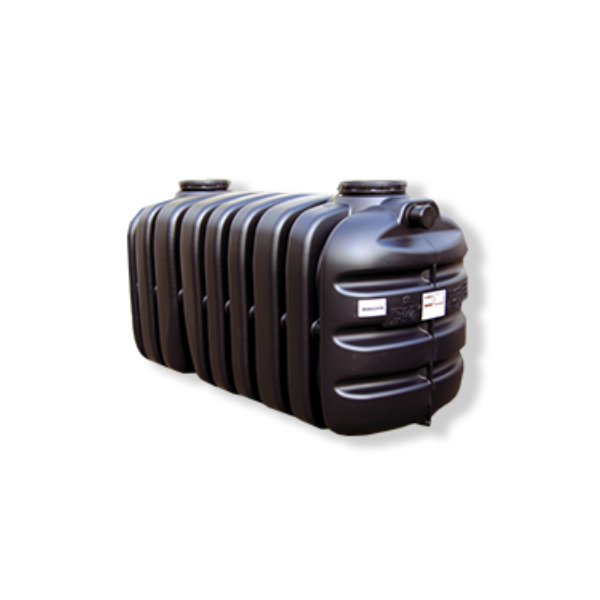
Tricel Vento Septic Tank
Shallow dig tank, strong & robust underground tank, No electrical or moving parts. Ideal for sites with good drainage & plenty of space.
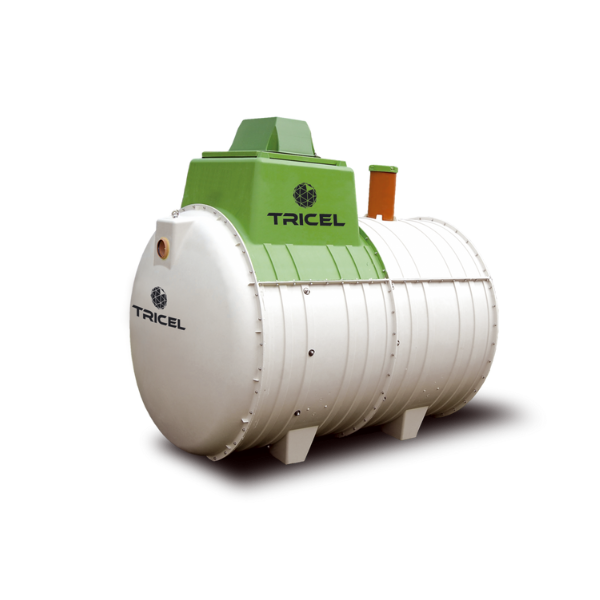
Tricel Novo Sewage Treatment Plant
Durable & long lasting SMC tank, shallow dig tank, easy installation (Plug and Play), long life components.
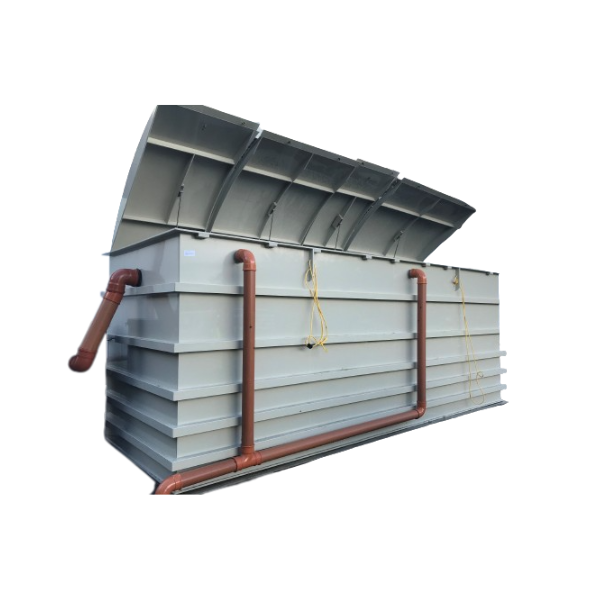
Tricel Maxus Sewage treatment Plant
Commercial plant. Submerged Aerated Filter (SAF) technology. Ideal for every project over 50 Population Equivalent.
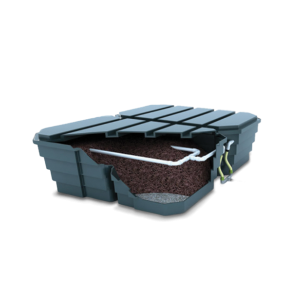
Tricel Puraflo Packaged filter
Ideal for sensitive sites, compliant to British Standard, small footprint.
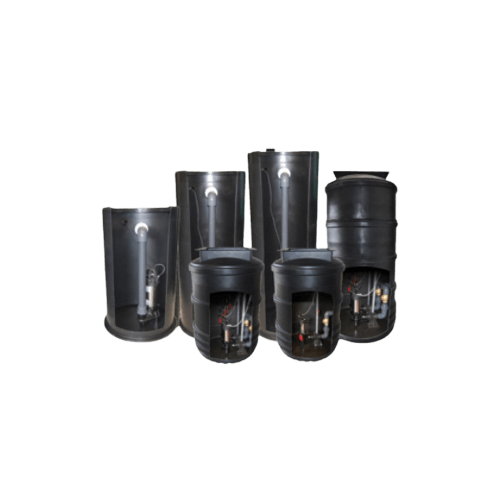
Tricel Pumping Stations
Pump fluids from one place to another where gravity drainage cannot be used, easy and trouble-free installation
MEET OUR TEAM
To find a technician in your area, visit our page
TALK SEWAGE TREATMENT
To speak to one of our agents online, click here
ASK FOR A QUOTE
Request a free quote today to have a quote that meets your project!
Key Features

Fast Delivery
Fast delivery + Rapid response to all our customers

Certified
Tricel Products are certified to EN12566-1 and EN 12566-3 certified

Technical expertise
Unrivalled technical expertise by our sales team regarding wastewater treatment solutions
Frequently Asked Questions
A cesspool is a simple storage vessel with an inlet and no outlet. It’s a sealed storage vessel; all the water coming in stays within the tank. The advantage is it doesn’t need an outlet. The disadvantages are: there is no treatment, the tanks are huge, and it needs regular emptying. Everything which has gone in must be sucked out. Ideal for sites which have got very infrequent use (Sheppard huts, for example).
A septic tank has an inlet and an outlet; it’s a simple overflow system. See how a septic tank works here. The advantages of the septic tank are there is no mechanic and no electricity requirement for it to work. The disadvantages are you are discharging dirty water, and untreated sewage effluent, as a tiny breakdown has occurred in the tank. You can only release water to a drainage field for the water to go through the subsoil to treat the water.
A sewage or package treatment plant has an inlet and an outlet; the wastewater is treated inside the tank. Aeration is provided inside the tank for the aerobic bacteria to feed on the waste and remove it from the liquid. The advantages are the wastewater is treated and can be discharged to a watercourse.
Many package treatment plants are available on the market:
- Trickles filters
- Rotating Biological Contactors (RBC)
- Mobile media bio-reactors
- Activated Sludge systems
- Sequence Batch Reactor systems (SBR)
- Fixed Bed Systems (like the Tricel Novo)
Domestic wastewater is all wastewater generated inside the house, including grey water from sinks, showers, baths and sewage from toilets. Rainwater is not classified as greywater and should be directed to a soakaway.
A trial hole can be dug during the site assessment and left open for 48 hours to determine this. The ground level is used to measure the water level.
After the water is discharged, it must flow into a drainage field or a running watercourse. It will fail and block up very quickly whenever it is released directly into the ground. It will also violate the government’s General Binding Rules for small sewage discharges—more information on this page.
Get in touch